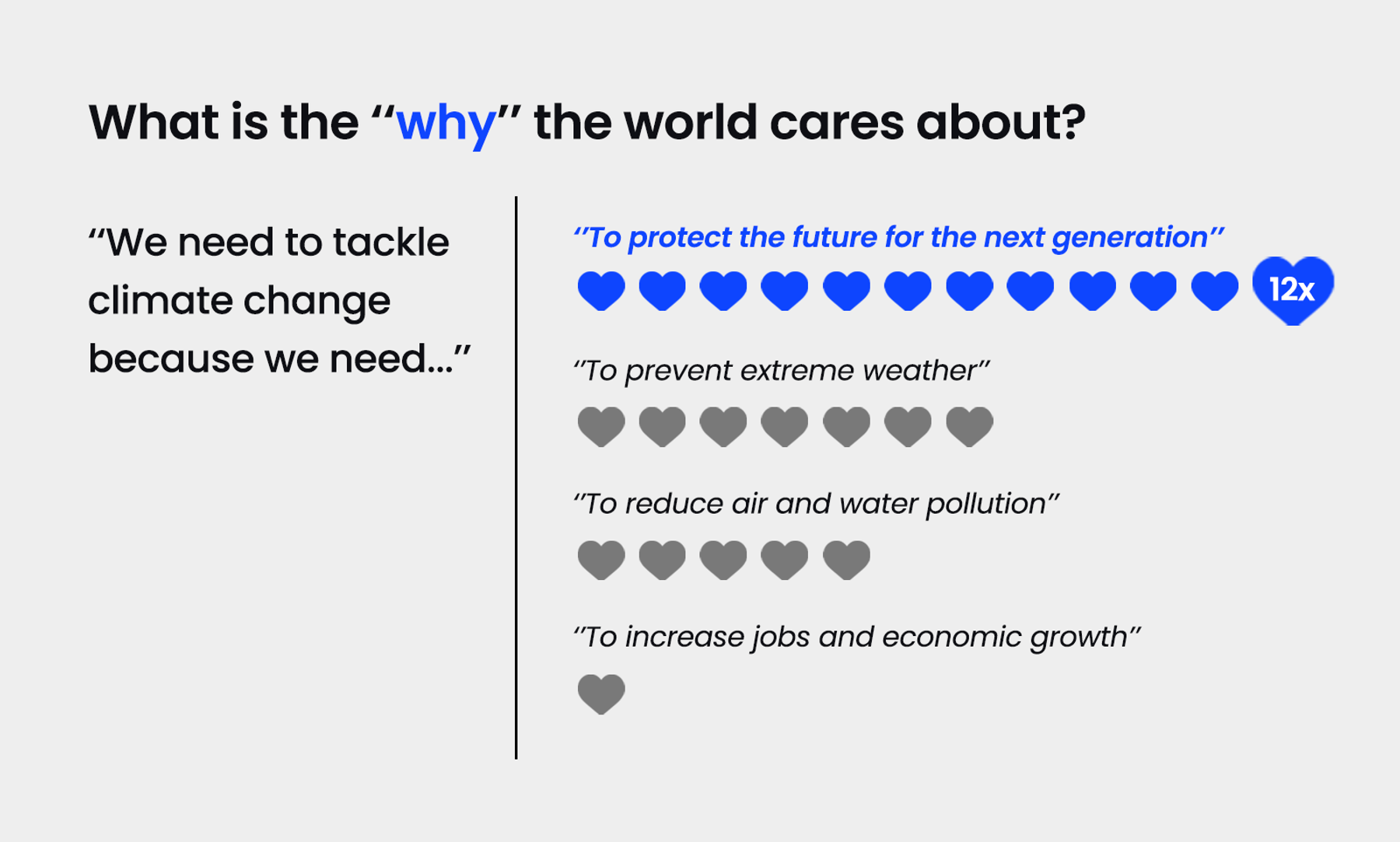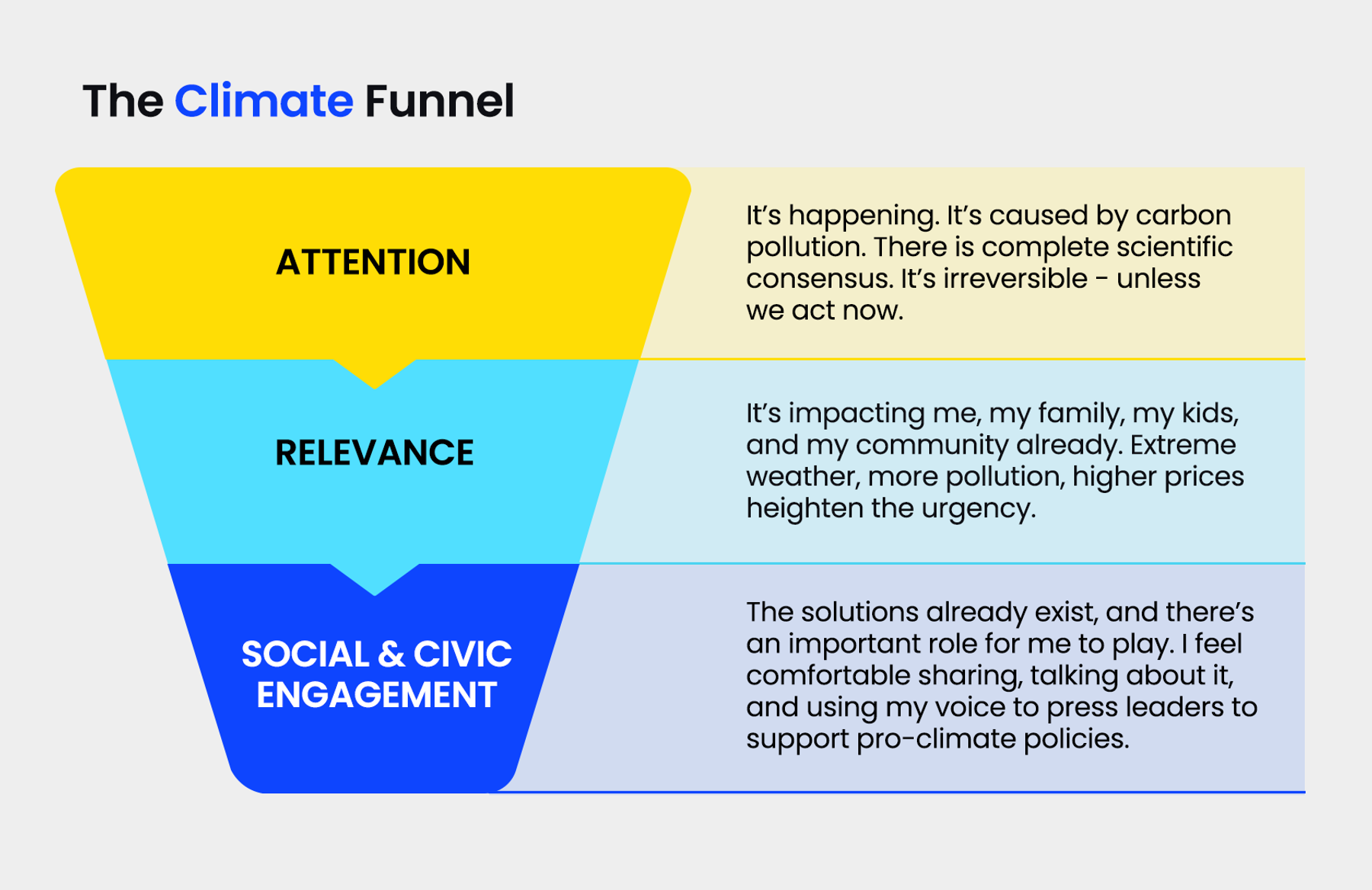About five years ago, longtime marketing executive John Marshall received a wake-up call from an unexpected source: his teenage son. According to him, “I was a useless idiot for spending my skills trying to sell soap and shampoo and credit cards,” Marshall remembers. His son had been taking a course on climate change and demanded that his father put his marketing skills – and network of top executives – to work for the cause. Marshall spent the weekend making calls, and soon, the not-for-profit Potential Energy Coalition was born. The organization calls itself the “marketing firm for planet Earth” with a mission to use “the power of storytelling and the most advanced marketing and analytics tools on the planet to drive public demand and accelerate the global energy transition.”
Today, Potential Energy combines rigorous audience research with strategic storytelling to craft campaigns that deeply resonate with people’s values. Their research—spanning 23 countries and 60,000 participants—revealed a universal truth: the most motivating climate message isn’t about extreme weather, green jobs, or innovation. The idea that actually moves the needle and sparks action is about protecting what we love, especially our children and future generations.

This insight inspired a groundbreaking commercial aired during the Super Bowl this year – part of Potential Energy’s Science Moms campaign. In “By the Time,” a mother reflects on the climate destruction that will unfold in her newborn daughter’s lifetime if left unchecked. “Our window to act on climate change is like watching them grow up,” she says. “We blink, and we miss it.”
Led by women scientists, the long-running campaign connects climate science to practical steps parents can take to safeguard their families. Generating over 3 billion video views and a nine-point increase in climate support among suburban women in key areas, Science Moms shows the power of meeting people where they are – with shared values and accessible actions.
Potential Energy also works closely with community organizations, political leaders, and trusted local voices to ensure their campaigns resonate. From parenting blogs to "Talk Like a Human" handbooks, their goal is to make climate messaging relatable and actionable, breaking through the noise of jargon and partisanship.
The climate issue doesn’t stand alone, we need to relate it to the things people are actually struggling with.
John Marshall
Waverley Street recently spoke with the team at Potential Energy, including CEO John Marshall, Associate Director, Strategy and Insights, Jessica Lu, and Head of Strategy and Analytics Sergio Velasquez-Rose.
Waverley Street: John, tell me about the gap you were trying to fill when you started Potential Energy.
John Marshall: The climate narrative has been really generated through two types of people: scientists and policymakers. A lot of really valuable, critical work has been done by scientists and policymakers. But their narratives can be way too complicated and way too political. So we ended up in a place where climate communication was complicated and political.
The thing about marketers, unlike advocacy organizations, is that we don't come to it with a point of view, with an angle – we come to it with our ears open. How do we learn what regular people's lives are like? What are they struggling with? We spend 90% of our time listening and learning, and then we figure out how to design a product or a message in order to meet people where they are.
I'll give you an example. The first thing we did was say, “Let's go to places that are flooding and we’ll find out how to talk about climate change, because that's ground zero for climate.” So we ran all these focus groups and decided we weren’t going to tell them why we're here. We're just going to learn about their lives. And so, you're in the worst flood zones on the planet, and you're at minute 45 in the interview and they're talking about things like, “there's too much traffic,” or, “the shopping isn't very good” and you think, “wait, when are you going to bring my issue up?!” The thing we quickly realized is that the climate issue doesn’t stand alone, we need to relate it to the things people are actually struggling with.
Waverley: Another critique of the early marketing was that it was focused too much on polar bears or ice caps, and not enough on people. Is that what you found through your work?
Marshall: Some people do care about species protection. A lot of people care about what their home insurance costs are. They certainly care about the air that they're breathing. Everybody cares about the next generation.
Sergio Velasquez-Rose: We conducted a study across 23 countries trying to understand this key question, and interviewed 60,000 people around the world. What we came out with is “protecting what we love.” Love for the next generation is the great unifier that gets people to care about climate change – more so than extreme weather damages, many times more so than innovation or jobs.
Jessica Lu: The theme that we kept seeing over and over again was that this message around protecting our kids seemed to be working. We've had online forums and panels with over 150 people in 8 key countries, and they would say, “Of course it's for our kids that we should be thinking about climate action.” I think they're seeing these extreme weather events in their day to day lives and they intuitively make that connection, thinking, “what does that mean for my child who's going to grow up in this world?”

Waverley: Can you talk more about the power of community, and how you work with other organizations to have an impact?
Marshall: Our theory of change is that more powerful narratives can accelerate progress, and if we tell stories that resonate to people's truth, then those will create more climate support and greater public will and we'll get the policies that we need way, way faster.
The first thing we do is we try to figure out what are the powerful narratives that resonate with individuals, but the actual work is threefold. One is making sure that leaders know what those narratives are. The second is, we run marketing campaigns to spread those narratives out, so that's social media and TV. But the third one is that we build partnerships with local communities to engage with them so we can help them with their narratives, and they can be an avenue for change at the local level. The sum total of community wisdom is very high. Those community organizations don't necessarily have all the analytical tools that we have, but they have a great amount of insight. And so, the two-way street is to listen and understand what the folks in those communities’ lives are like and what motivates them, and then to provide marketing expertise to those organizations.
Learn more about our grantee partner, Potential Energy.





